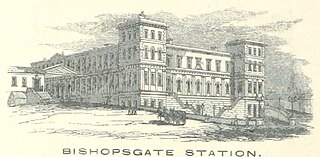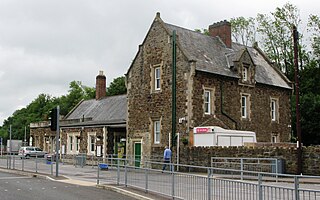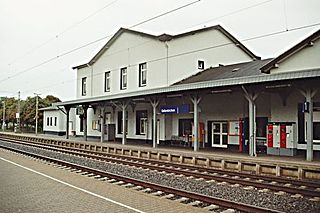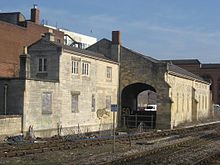
Bristol Temple Meads is the oldest and largest railway station in Bristol, England. It is located 118 miles 31 chains away from London Paddington. It is an important transport hub for public transport in the city; there are bus services to many parts of the city and surrounding districts, with a ferry to the city centre. Bristol's other major station, Bristol Parkway, is a more recent station on the northern outskirts of the conurbation.

A railroad car, railcar, railway wagon, railway carriage, railway truck, railwagon, railcarriage or railtruck, also called a train car, train wagon, train carriage or train truck, is a vehicle used for the carrying of cargo or passengers on a rail transport network. Such cars, when coupled together and hauled by one or more locomotives, form a train. Alternatively, some passenger cars are self-propelled in which case they may be either single railcars or make up multiple units.
The Leek and Manifold Valley Light Railway (L&MVLR) was a narrow gauge railway in Staffordshire, England that operated between 1904 and 1934. The line mainly carried milk from dairies in the region, acting as a feeder to the 4 ft 8+1⁄2 instandard gauge system. It also provided passenger services to the small villages and beauty spots along its route. The line was built to a 2 ft 6 in narrow gauge and to the light rail standards provided by the Light Railways Act 1896 to reduce construction costs.

Bishopsgate was a railway station located on the eastern side of Shoreditch High Street in the parish of Bethnal Green on the western edge of the East End of London and just outside the City of London.

A siding, in rail terminology, is a low-speed track section distinct from a running line or through route such as a main line, branch line, or spur. It may connect to through track or to other sidings at either end. Sidings often have lighter rails, meant for lower speed or less heavy traffic, and few, if any, signals. Sidings connected at both ends to a running line are commonly known as loops; those not so connected may be referred to as single-ended or dead-end sidings, or stubs.

A rail yard, railway yard, railroad yard (US) or simply yard, is a series of tracks in a rail network for storing, sorting, or loading and unloading rail vehicles and locomotives. Yards have many tracks in parallel for keeping rolling stock or unused locomotives stored off the main line, so that they do not obstruct the flow of traffic. Cars or wagons are moved around by specially designed yard switcher locomotives (US) or shunter locomotives (UK), a type of locomotive. Cars or wagons in a yard may be sorted by numerous categories, including railway company, loaded or unloaded, destination, car type, or whether they need repairs. Yards are normally built where there is a need to store rail vehicles while they are not being loaded or unloaded, or are waiting to be assembled into trains. Large yards may have a tower to control operations.

Newton Abbot railway station serves the market town of Newton Abbot in Devon, England. It is 214 miles 5 chains (345 km) from London Paddington. The station today is managed by Great Western Railway, who provide train services along with CrossCountry.

Rail freight transport is the use of railroads and trains to transport cargo as opposed to human passengers.

Salisbury railway station serves the cathedral city of Salisbury in Wiltshire, England. It is 83 miles 43 chains (134.4 km) from London Waterloo on the West of England line to Exeter St Davids. This is crossed by the Wessex Main Line from Bristol Temple Meads to Southampton Central. The station is operated and served by South Western Railway (SWR), and is also served by Great Western Railway (GWR).

Tinsley was a railway marshalling yard near Tinsley in Sheffield, England, used to separate railway wagons from incoming trains and add them to new trains. It was sited immediately west of the M1 motorway, about one mile north of the Catcliffe junction. It was opened in 1965, as a part of a major plan to rationalise all aspects of the rail services in the Sheffield area; it closed in stages from 1985, with the run-down of rail freight in Britain. It was also the site of Tinsley Traction Maintenance Depot (TMD), which was closed in 1998; at its peak, 200 locomotives were allocated to this depot.

Barnstaple railway station is the northern terminus of the Tarka Line and serves the town of Barnstaple, Devon. It is 39 miles 75 chains (64.3 km) from Exeter Central and 211.25 miles (339.97 km) from London Waterloo. It is managed by Great Western Railway, which also operates the passenger service.

The rail network of Melbourne, Australia, has a significant number of railway lines and yards serving freight traffic. Rail transport in Victoria is heavily focused on Melbourne, and, as a consequence, much of the state's rail freight passes through the metropolitan network.

Adlestrop railway station was a railway station which served the village of Adlestrop in Gloucestershire, England, between 1853 and 1966. It was on what is now called the Cotswold Line. The station was immortalised in the poem "Adlestrop" by Edward Thomas after his train stopped there on 24 June 1914.

A goods station or freight station is, in the widest sense, a railway station where, either exclusively or predominantly, goods, such as merchandise, parcels, and manufactured items, are loaded onto or unloaded off of ships or road vehicles and/or where goods wagons are transferred to local sidings.
The Salisbury branch line of the Great Western Railway from Westbury to Salisbury in Wiltshire, England, was completed in 1856. Most of the smaller stations were closed in 1955 but the line remains in use as part of the Wessex Main Line.
Witney goods station served the Oxfordshire town of Witney on the Oxford, Witney and Fairford Railway. It consisted of seven sidings, a goods shed, a wooden parcel office and a cattle dock. It also had an engine shed, which was demolished early in the twentieth century. Following the opening of the East Gloucestershire Railway in 1873, the station became a goods depot, with passengers using the second station situated to the south. The original station remained open to goods traffic until 1970.
The Cambridge Branch is a rural railway line in the Waikato, New Zealand. The line stretches from Ruakura Junction for 15.08 kilometres (9.37 mi) to the settlement of Hautapu, having previously continued another 4.19 kilometres (2.60 mi) to the township of Cambridge. It had five stations along its length, at Newstead, Matangi (Tamahere), Bruntwood (Fencourt), Hautapu and the terminus at Cambridge.

A train station, railroad station, or railroad depot and railway station is a railway facility where trains stop to load or unload passengers, freight, or both. It generally consists of at least one platform, one track, and a station building providing such ancillary services as ticket sales, waiting rooms, and baggage/freight service. If a station is on a single-track line, it often has a passing loop to facilitate traffic movements.

Geilenkirchen station is in Geilenkirchen in the German state of North Rhine-Westphalia on the Aachen–Mönchengladbach railway. It is the only railway station in the town of Geilenkirchen. It provided an interchange between the mainline railway and the Geilenkirchen District Railway until 1971 and was a stop for long-distance traffic until 2001. It is classified by Deutsche Bahn as a category 4 station.

Freital-Hainsberg station is a station on the Dresden–Werdau railway in the district of Hainsberg of the municipality of Freital in the German state of Saxony. The Weißeritz Valley Railway branches off to Kipsdorf from the station. Since 31 May 1992, the station has been served by the Dresden S-Bahn.

















